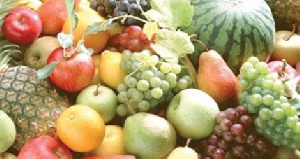Market for fresh fruits and fresh juice in Accra is estimated at 402 million dollars, representing 17 per cent of total non-traditional export for 2011.
Among the fresh fruits, oranges are the most favourite fruits in the metropolitan area, followed by pineapple, mango, watermelon and pawpaw in that order. Onions, tomatoes, carrots, cabbages and okro are the top most favourite vegetables in the metropolitan areas.
A market survey conducted in three markets by Agri-Impact Consult, providers of Agri-business Services and innovative Solutions to assess potential sub- regional and local markets for Ghanaian horticultural produce revealed that demand for horticultural produce were very encouraging.
Mr Dan Acquaye, Executive Director of Agri-Impact Consult speaking at a workshop organised for stakeholders in the horticultural sector said mango, banana, oranges and pineapple have a growth rate of 100 per cent per annum. The study covered 393 local operators in Accra, Tema, Kumasi, Obuasi, Techiman, Wenchi, Cape Coast, Takoradi and Ada.
It was supported by the Ministry of Food and Agriculture (MOFA) in collaboration with the African Development Bank’s Export Marketing and Quality Awareness Project (EMQAP). EMQAP was to address the marketing challenges of horticultural produce and introduce new fruits and vegetables for both the local and external markets.
Mr Acquaye said about 90 per cent of market women consider post-harvest and food safety education in the markets as a major challenge and called on all stakeholders to step up their efforts in that direction.
He said because of lack k of basic infrastructure like sheds, cold rooms and packing areas, about 40 per cent of the produce rots before they are sold out and appealed to the Metropolitan, Municipal and District Assemblies (MMDAs) to provide adequate infrastructures in the market to save the situation.
“Domestic markets accounts for 95 per cent and 35 per cent of total vegetables and fruits production. Accra markets alone account for 402 million dollars per annum.” “Demand for major fruits and vegetables has increased over 50 per cent over the four years with mango being the most highly consumed fruits in Ghana and the growth has increased over 100 per cent in the last four years,” he added.
Mr Acquaye therefore suggested the establishment of horticulture and vegetable economic zones to promote the production and consumption of those produce. He said the establishment of such economic zones would in turn benefit the country as well as the farmers as it would be used as growth post to stimulate the market.
He also stressed the need to promote productivity and enhance strategies to promote strategic cooperation, as we as step up skills for processors to add value and thereby increase income. “We need to promote value chain financing to stimulate production and develop skills and professionalism as well,” he said.
Mr Mawuli Agboka, EMQAP project Coordinator, said the continuous decline in the price of pineapples in the export market had been big concerns for both government and the players as well. He said there had been lots of investments in the industry since 2005 including the 28 million project devoted to infrastructure development to improve the industry.
“Government has put in several interventions to keep the industry functioning,” he said and expressed the hope that the industry would pick up again. “I believe that if the industry is done well, the pineapple industry can be one of the tools that the government can use to address poverty in the country,” Mr Agboka said.
Mr Tabi Karikari, Agricultural and Natural Resources Management Officer, Africa Development Bank, Ghana Country office, said they were looking at inclusive growth that cut across geographical position, equitable distribution, gender and age and commended the partners for their efforts over the years.
Business News of Friday, 3 January 2014
Source: GNA

















